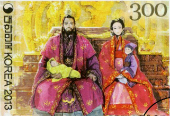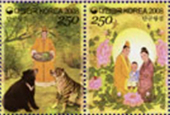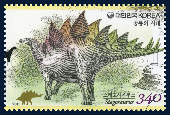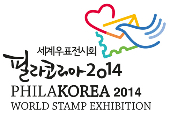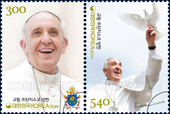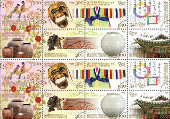- 한국어
- English
- 日本語
- 中文
- العربية
- Español
- Français
- Deutsch
- Pусский
- Tiếng Việt
- Indonesian
In 1969 and 1970, Korea Post printed a series of stamps featuring five traditional children's folktales. Kids today may read fairytales by Hans Christian Andersen, or even tales from the brothers Grimm. Some just read the reinvented Disney stories and some may just know cartoons, like Pororo or Robocar Poli. However, classics that pertain to the golden rule -- that the good are rewarded and that the bad are punished -- can be said to hold true to traditional values and decorum.
Folktales like that of Kongjwi and Patjwi -- literally Bean Mouse and Red Bean Mouse -- the rabbit's liver, the sun and the moon, the heavenly maiden and the woodcutter and, finally, Heungbu and Nolbu can all be such representative tales. Of course, just because they are Korean folktales doesn't mean that they're that different from tales found elsewhere in the world.
Through the five series of stamps, showing four major scenes from each story, we hope to find a commonality with the better known tales from the West. We hope to find a common chain of thought that flows through the minds of all humankind when they tell tales of the past. Enjoy the sense of longing from the classic art style of the stamps and learn that in the past stamps cost only five, seven, ten or twenty won.
This week's story is about two stepsisters each called Kongjwi and Patjwi.
Kongjwi and Patjwi
The first series printed on September 1, 1969, features the heroine of the " Kongjwi and Patjwi " story, Kongjwi herself, who is a kind and hard-working young woman. She is always falling into hardship due to her stepmother and evil stepsister, Patjwi. Kongjwi must hoe the stony field, fill a leaking water cistern to the brim and complete what are impossible tasks for an ordinary being.
Nevertheless, the good heroine overcomes all these hardships with the help of a cow, a toad and the sparrows, and even wins love at the end, surpassing Patjwi. Some see similarities to the Western tale of Cinderella.

The Kongjwi and Pattgwi stamps were printed on September 1, 1969. (From left) Kongjwi is scolded by her stepmother; sparrows help Kongjwi; a cow helps Kongjwi; Kongjwi is carried off to be married happily ever after. (image courtesy of Korea Post)
By Paik Hyun
Korea.net Staff Writer
cathy@korea.kr
